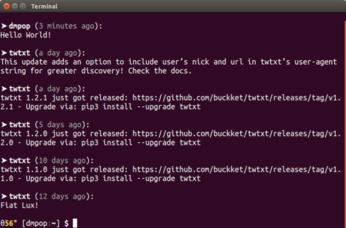twtxt: Microblogging for Hackers

Productivity Sauce
Maybe you are not keen on using closed and tightly-controlled third-party microblogging services like Twitter. Or maybe you are just looking for a straightforward way to share your thoughts with the world directly from the command-line. In either case, twtxt might be something right up your alley. This little tool makes it possible to push updates and follow other twtxt users from the convenience of the terminal. The clever part is that twtxt stores your updates in a plain text file. Make this file publicly accessible via HTTP and other users can subscribe to your stream.
twtxt is written in Python 3, and the easiest way to install it on your system is through the PIP tool. To do this on Debian and Ubuntu-based Linux distributions, run the following commands as root:
apt-get install python3-pip pip3 install twtxt
Run then the twtxt quickstart command to configure basic settings, and you are good to go. twtxt features a handful of simple commands. To post an update, use the twtxt tweet command followed by the update message, for example: twtxt tweet "Hello World!". The twtxt timeline lets you view your stream, while the twtxt view twtxt shows the feed of the specific user (twtxt in this case). To follow another twtxt user, use the twtxt follow twtxt https://buckket.org/twtxt_news.txt command (you need to replace the example user and path with the actual values). For further info on using twtxt, head over to twtxt documentation. And if you want to follow yours truly, I'm dmpop and my twtxt URL is http://dmpop.dhcp.io/twtxt.txt.
comments powered by DisqusSubscribe to our Linux Newsletters
Find Linux and Open Source Jobs
Subscribe to our ADMIN Newsletters
Support Our Work
Linux Magazine content is made possible with support from readers like you. Please consider contributing when you’ve found an article to be beneficial.

News
-
Parrot OS Switches to KDE Plasma Desktop
Yet another distro is making the move to the KDE Plasma desktop.
-
TUXEDO Announces Gemini 17
TUXEDO Computers has released the fourth generation of its Gemini laptop with plenty of updates.
-
Two New Distros Adopt Enlightenment
MX Moksha and AV Linux 25 join ranks with Bodhi Linux and embrace the Enlightenment desktop.
-
Solus Linux 4.8 Removes Python 2
Solus Linux 4.8 has been released with the latest Linux kernel, updated desktops, and a key removal.
-
Zorin OS 18 Hits over a Million Downloads
If you doubt Linux isn't gaining popularity, you only have to look at Zorin OS's download numbers.
-
TUXEDO Computers Scraps Snapdragon X1E-Based Laptop
Due to issues with a Snapdragon CPU, TUXEDO Computers has cancelled its plans to release a laptop based on this elite hardware.
-
Debian Unleashes Debian Libre Live
Debian Libre Live keeps your machine free of proprietary software.
-
Valve Announces Pending Release of Steam Machine
Shout it to the heavens: Steam Machine, powered by Linux, is set to arrive in 2026.
-
Happy Birthday, ADMIN Magazine!
ADMIN is celebrating its 15th anniversary with issue #90.
-
Another Linux Malware Discovered
Russian hackers use Hyper-V to hide malware within Linux virtual machines.

